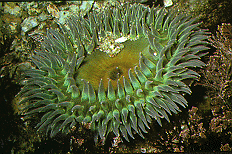Anthozoa
Anthozoa are a class in the phylum Cnidaria. It includes the sea anemones and the corals. It is a monophyletic clade, one of two in the Cnidaria. The other is the Medusozoa.[1]
| Anthozoa Temporal range:
late Ediacaran to present | |
|---|---|

| |
| Stony corals | |
| Scientific classification | |
| Kingdom: | |
| Phylum: | |
| Class: | Anthozoa
|
| Subclass: | |

Giant green anemone, Southern California
The class does not have a medusa larval stage in its development, unlike the rest of the phylum. Like all Cnidaria, their food-catching and defense are done by nematocysts, which are extremely effective stinging cells. Over 6,100 species have been described.[2][3]
There are three subclasses:
- Ceriantharia: the tube-dwelling anemones or cerianthids
- Hexacorallia: 4,300 species of colonial polyps, usually with 6-fold symmetry. This includes all of the stony corals, which are vital for coral reef formation, and all sea anemones, and zoanthids.
- Octocorallia: 3,000 species of colonial polyps with 8-fold symmetry.[1] It includes the blue coral, soft corals, sea pens, and gorgonians (sea fans and sea whips).
Anthozoa Media
Deep water corals serve as habitats for fish such as the alfonsino
References
- ↑ 1.0 1.1 Daly M. et al 2007. The phylum Cnidaria: a review of phylogenetic patterns and diversity 300 years after Linnaeus. Zootaxa, 1668: 127–182, Wellington. Abstract - PDF
- ↑ Crowther A.L. (2011). "Class Anthozoa Ehrenberg, 1834" (PDF). In Z.-Q. Zhang (ed.). Animal biodiversity: an outline of higher-level classification and survey of taxonomic richness. Zootaxa. Vol. 3148. pp. 19–23. doi:10.11646/zootaxa.3148.1.5.
- ↑ estimates of species numbers differ between authorities.










